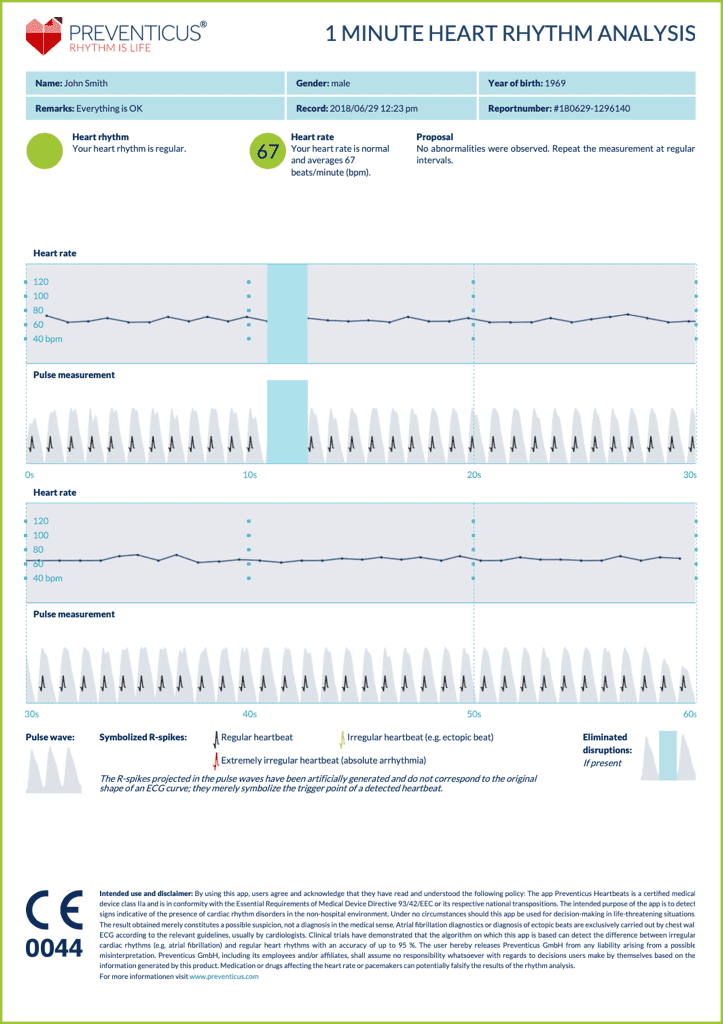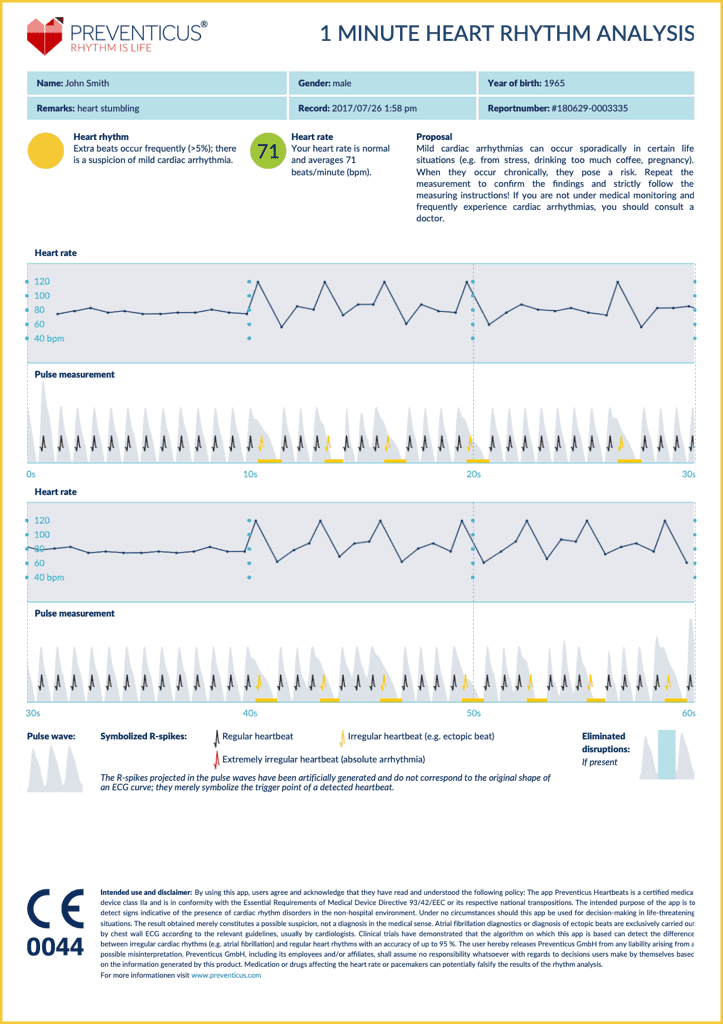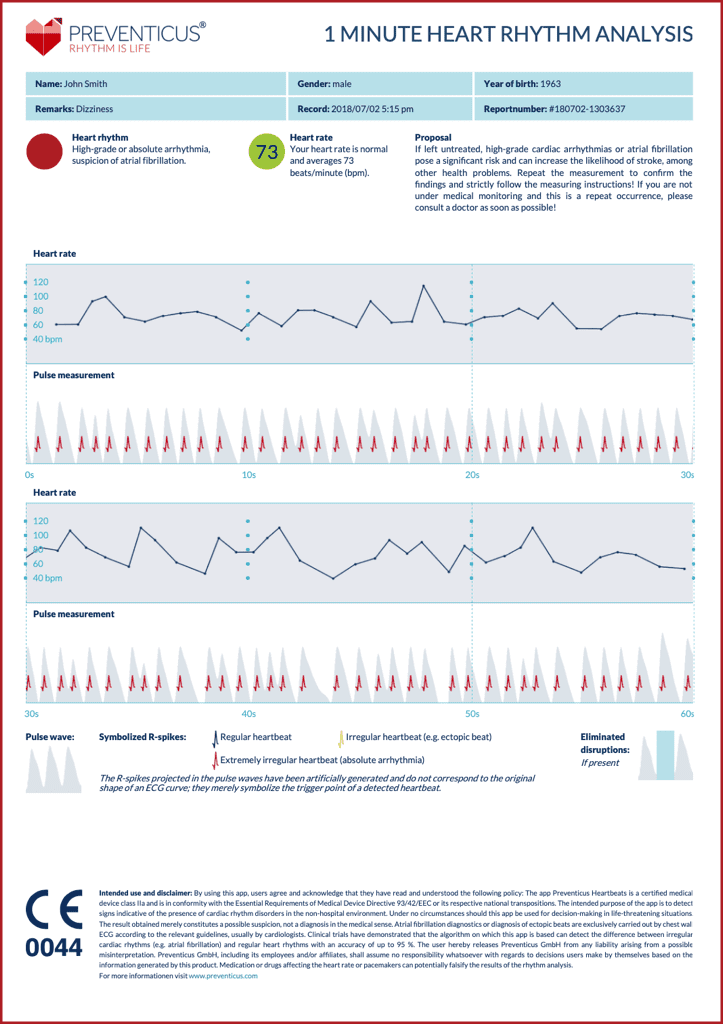
die hat doch jeder!“
Sowie bereits ab 55 Jahren bei Vorliegen weiterer Risikofaktoren, wie z.B. Bluthochdruck, Diabetes oder frühere Herz-Kreislauf-Ereignisse.





Sowie bereits ab 55 Jahren bei Vorliegen weiterer Risikofaktoren, wie z.B. Bluthochdruck, Diabetes oder frühere Herz-Kreislauf-Ereignisse.



When your heart loses its rhythm
Cardiac arrhythmias, especially undetected atrial fibrillation, is associated with a greatly increased risk of stroke. It frequently goes undetected, often occurs only sporadically and is therefore difficult to diagnose by a standard care.
When atrial fibrillation is detected, the danger of blood clots and the risk of a stroke can be significantly reduced and almost normalised by using medication, for instance.
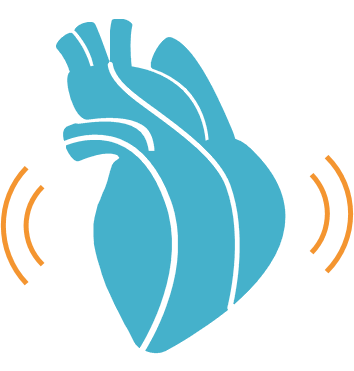
Atrial fibrillation is the irregular beating of your heart, which causes an irregular blood flow.

This, in connection with other pathophysiological mechanisms, can lead to dangerous blood clotting.
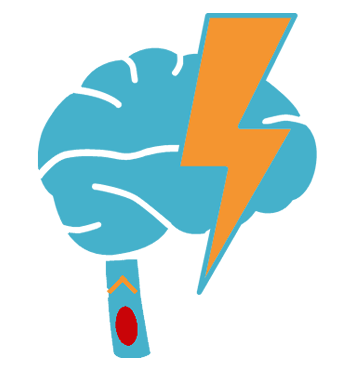
Blood clots that travel from the heart to the brain could cause a stroke.
Dr Heart explains

Mit dem Laden des YouTube-Videos willigen Sie zugleich gem. Art. 49 Abs. 1 S. 1 lit. a DSGVO ein, dass dabei Daten Ihres Endgeräts (z.B. IP- Adresse) in den USA verarbeitet werden. Die USA gelten als Land mit einem nach EU-Standards unzureichendem Datenschutzniveau. Es besteht insbesondere das Risiko, dass Ihre Daten durch US-Behörden zu Überwachungszwecken, auch ohne Rechtsbehelfsmöglichkeiten, verarbeitet werden.
Hier mehr über die Cookie-Verwendung von YouTube auf Google.com erfahren
Forewarned is forearmed.
If atrial fibrillation is detected and subsequently confirmed by your doctor using an ECG, the risk of a stroke can be reduced and even normalised through medication. It is crucial to use Preventicus Heartbeats on a regular basis, twice a day for at least 14 days or every other day for 3 months as well as when an irregular heartbeat is detected.
Studies with small ECG appliances for self-use have shown that these devices detect more arrhythmias and atrial fibrillation episodes with a similar measuring procedure to long-term 24-hour ECGs (Holter ECGs).3,4
3 T. Hendrikx, BMC Cardiovascular Disorders 2014.
4 Freedman, J Camm et al. Screening for Atrial Fibrillation. Circulation. 2017;135:1851-1867

How to read your PDF report. Watch a short video.
Using pulse curves, the algorithm precisely determines the frequent occurrence of extrasytoles or the presence of an absolute arrhythmia with suspected atrial fibrillation (see clinical studies).
If more than 5% of all beats are extrasystoles, the Preventicus Heartbeats app indicates a suspected mild arrhythmia with a yellow light. A red light indicates a presence of an absolute arrhythmia (Suspicion of atrial fibrillation). The app also informs you of any relevant permanently low (bradycardia) or high pulse (tachycardia). Any disruptions during the measurement (shaking, coughing, wobbling etc.) are automatically detected and eliminated.
The full version of the Preventicus Heartbeats app also creates a PDF report, containing the original pulse curves recorded over 1 or 5-minutes period and the R waves that symbolise each cardiac cycle. This allows your doctor to understand the automatic interpretation and visually assess your heart rhythm.
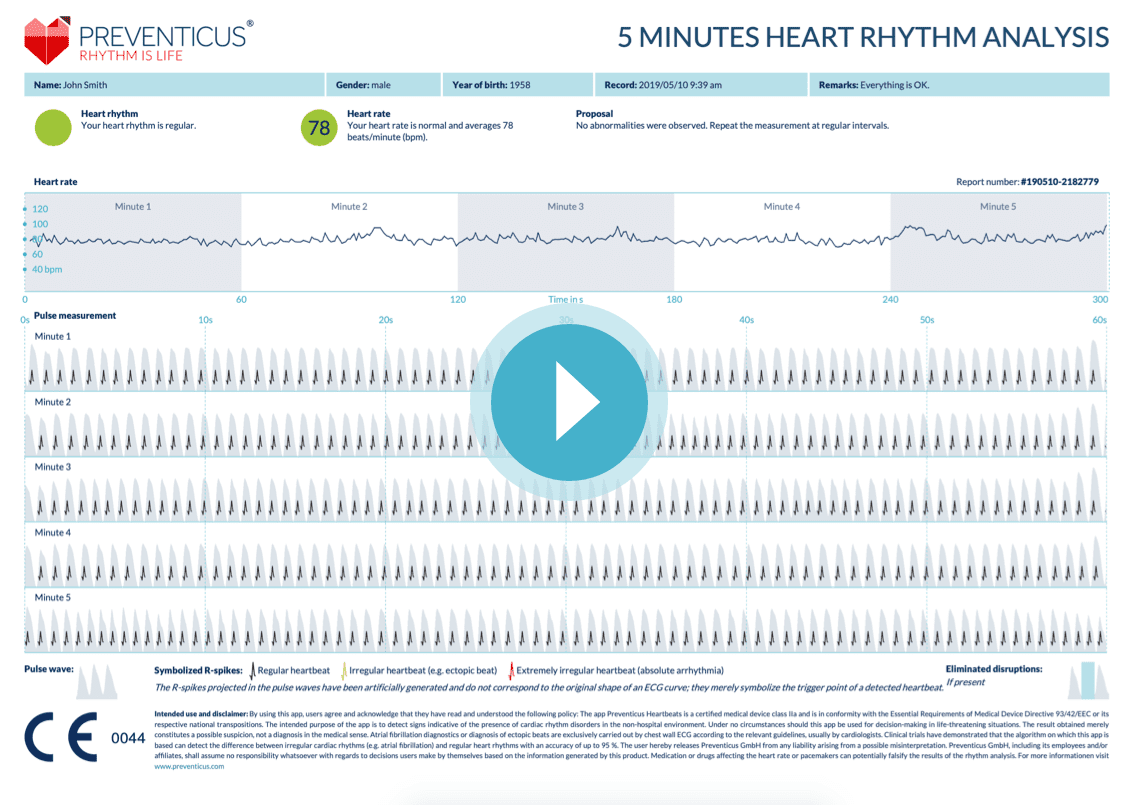
Mit dem Laden des YouTube-Videos willigen Sie zugleich gem. Art. 49 Abs. 1 S. 1 lit. a DSGVO ein, dass dabei Daten Ihres Endgeräts (z.B. IP- Adresse) in den USA verarbeitet werden. Die USA gelten als Land mit einem nach EU-Standards unzureichendem Datenschutzniveau. Es besteht insbesondere das Risiko, dass Ihre Daten durch US-Behörden zu Überwachungszwecken, auch ohne Rechtsbehelfsmöglichkeiten, verarbeitet werden.
Hier mehr über die Cookie-Verwendung von YouTube auf Google.com erfahren
Also use in these situations.
Measuring your heart rhythm regularly helps in prevention. Just as important as regular blood pressure measurements, Preventicus Heartbeats should therefore be your constant companion in situations occurring in life where heart rhythm disorders occur with a greater frequency and, if left undetected, can have fatal consequences in the face of risk factors like High blood pressure, Heart palpitations, Arrhythmia (or atrial fibrillation), Previous heart attack, Diabetes, Age > 55 years.
Heart palpitations harmless to serious
Irregular heartbeats (extrasystoles), which present themselves as cardiac arrhythmias in many affected individuals, are usually entirely harmless and generally do not require a trip to the doctor’s.
However, medical assessment is necessary when arrhythmias last for minutes or hours, or when they lead to other significant symptoms such as dizziness, impaired consciousness or shortness of breath. Further assessment is required when a heart condition is already present and arrhythmias emerge.
Clinical studies have shown that those who suffer from cardiac arrhythmias are more at risk of developing atrial fibrillation.
High blood pressure and cardiac arrhythmia two dangerous companions – High blood pressure (hypertension) is by far the biggest risk factor when it comes to the development of cardiac arrhythmias.
There is a direct correlation between the blood pressure level and the probability of being afflicted by atrial fibrillation. The permanent pressure on the heart causes the myocardium to enlarge (hypertrophy). Due to this, the cardiac tissue no longer receives an optimal supply of blood and heart muscle cells begin to die off imperceptibly.
These cells are then replaced by connective tissue cells, which do not allow for adequate blood flow and therefore cause the normal “electrical system“ of the heart to go haywire, thus promoting cardiac arrhythmias.
Detect atrial fibrillation when it happens
Have you been diagnosed with atrial fibrillation or any other kind of arrhythmia and received treatment?
This therapy relies on two principles. First, the blood needs to be “thinned out” regularly (by means of blood-thinning agents called anticoagulants) in order to prevent the accumulation of blood clots (thrombi) and thereby minimize one’s risk of a stroke. Second, an attempt is made at normalizing the rhythm of the heart by drug treatment with antiarrhythmics or electrophysiological methods.
In most cases, these forms of heartbeat-stabilizing therapy are not permanent solutions. It is important, using responsible self-assessment, to be able to identify if and when cardiac arrhythmias happen. This way, your doctor will be able to decide on a form of therapy best suited for you.
Cardiac arrhythmia effects of a heart attack
A heart attack counts as one of the most frightening and distressing experiences in life. Now is the time to do everything in your power to ensure that such an event does not repeat itself. During a heart attack, regions of the heart tissue become damaged; myocardial cells die off and are overgrown with scar and connective tissue cells.
Such cells, however, are non-conductive and cause the regular “electrical system” of the heart to go haywire, thereby promoting the development of cardiac arrhythmias. This state is a very common late sequela of a heart attack. Up to one fifth of all heart attack patients develop atrial fibrillation.
Reducing risks after a stroke – A stroke counts as one of the most frightening and distressing experiences in life. Now is the time to do everything in your power to ensure that such an event does not repeat itself. You should try to minimize all risk factors and, above all, independently monitor your own health.
One major risk for another stroke would be the unexpected appearance of (previously untreated) atrial fibrillation or, for those already suffering from atrial fibrillation, after the effects of heartbeat stabilization therapy begin to wear off.
Diabetes and cardiac arrhythmia
The risk of suffering from cardiac arrhythmia in the form of atrial fibrillation is around two to three times higher for diabetics than in individuals with a healthy metabolism. That means diabetes is accompanied by a significantly higher risk for a stroke, as proven by numerous studies.
Particularly among younger diabetics, regular ECG tests or heart rhythm assessments are advisable to enable the rapid initiation of stroke prophylaxis, should atrial fibrillation occur. In the emergent or sporadically occurring phase of atrial fibrillation, the signs oftentimes do not show up on a standard ECG in the natural course at the doctor’s practice.
For heart palpitations during menopause
The hormonal changes during menopause not only bring about frequent hot flushes and sudden profuse sweating, but can also give rise to noticeable differences in heartbeat regularity. For women, clinical studies have not explicitly proven any increased heart and circulation risks during and after menopause or the influence of hormone therapy.
Regardless, skipped heartbeats and a racing heart are not uncommon signs accompanying these changes to the woman’s hormonal balance. The uncertainty as to whether these arrhythmias are harmless or indeed to be taken seriously is obviously another unpleasant accompaniment to the “change of life”.
Ensuring a healthy and vital life after 55
It is not only important to think of yourself, but also of your loved ones. The risk of atrial fibrillation doubles at the ages of 55 with each decade; no less than 10% of all 80-year-olds suffer from this condition.
Along with this comes the increased risk of late sequelae caused by atrial fibrillation; for 80-year-olds, the risk of suffering a stroke is already five times higher than in under 60-year-olds.
Legal disclaimer
Clinical studies have shown that the algorithm of the app is able to distinguish arrhythmias (such as atrial fibrillation) from a regular heart rhythm with an accuracy of up to 95%. This means that the Preventicus Heartbeats app did not detect the presence of an arrhythmia and/or incorrectly classed a normal heart rhythm as an arrhythmia in only 5% of all cases. Users of the app are aware of the slight possibility of such a miscalculation and release Preventicus GmbH of any liability due to such an error.
The results provided are solely intended for information purposes and should under no circumstances replace the personal diagnosis, consultation, care or treatment by medical or medically trained staff. The app is not intended for decision-making in acute situations nor for the real-time monitoring of vital signs. It should never supersede any existing diagnostic pathways or therapeutic measures according to the guidelines.
Preventicus and its organisations, directors, employees, agents, partners, affiliates and licensers do not accept any liability for decisions you make based on this information, such as the decision whether you seek care or treatment by medical professionals. You hereby relinquish any and all claims you have or will acquire in the future against Preventicus, its organisations, directors, employees, agents, partners, affiliates and licensers and declare to indemnify the aforementioned against any and all claims, procedures, costs, and direct or indirect damage in connection with your use of this information. This also applies to any lost profit.

